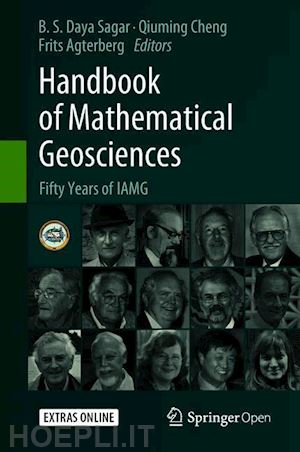Foreword
Preface
Introduction
B. S. Daya Sagar, Qiuming Cheng, Frits Agterberg
Part I Theory
1. Kriging, Splines, Conditional Simulation, Bayesian In-version and Ensemble Kalman Filtering Olivier Dubrule
1.1 Introduction
1.2 Deterministic Aspects of Geostatistics
1.3 Stochastic Aspects of Geostatistics: Conditional Simulation
1.4 Geostatistical Inversion of Seismic Data
1.5 Kalman Filtering and Ensemble Kalman Filtering
1.6 Beyond the Formal Relationship between Geostatistics and Bayes
1.7 Conclusion
References
2. A Statistical Commentary on Mineral Prospectivity analysis Adrian Baddeley
2.1 Introduction
2.2 Example Data
2.3 Logistic Regression
2.4 Poisson Point Process Models
2.5 Monotone Regression
2.6 Nonparametric Curve Estimation
2.7 ROC curves
2.8 Recursive Partitioning
References
3. Testing joint conditional independence of categorical random variables with a standard log-likelihood ratio test Helmut Schaeben
3.1 Introduction
3.2 From Contingency Tables to Log-Linear Models
3.3 Independence, Conditional Independence of Random variables
3.4 Logistic Regression, and its Special Case of Weightsof Evidence
3.5 Hammersley-Clifford Theorem
3.6 Testing Joint Conditional Independence of Categorical Random Variables
3.7 Conditional Distribution, Logistic Regression
3.8 Practical Applications
3.9 Discussion and Conclusions
References
4. Modelling Compositional Data. The Sample Space Ap-proach Juan José Egozcue and Vera Pawlowsky-Glahn
4.1 Introduction
4.2 Scale Invariance, Key Principle of Compositions
4.3 The Simplex as Sample Space of Compositions
4.4 Perturbation, a Natural Shift Operation on Compositions
4.5 Conditions on Metrics for Compositions
4.6 Consequences of the Aitchison Geometry in the Sample Space of Compositional Data
4.7 Conclusions
References
5. Properties of Sums of Geological Random Variables
G.M. Kaufman
5.1 Introduction
5.2 Preliminaries
5.3 Thumbnail Case Studies
References
6. A Statistical Analysis of the Jacobian in Retrievals of Satellite Data Noel Cressie
6.1 Introduction
6.2 A Statistical Framework for Satellite Retrievals
6.3 The Jacobian Matrix and its Unit-Free Version
6.4 Statistical Significance Filter
6.5 ACOS Retrievals of the Atmospheric State from Japan’s GOSAT Satellite
6.6 Discussion
References
7. All Realizations All the Time
Clayton V. Deutsch
7.1 Introduction
7.2 Simulation
7.3 Decision Making
7.4 Geostatistical Simulation
7.5 Resource Decision Making
7.6 Alternatives to All Realizations
7.7 Concluding Remarks
References
8. Binary Coefficients Redux Michael E. Hohn
8.1 Introduction
8.2 Empirical Comparisons and a Taxonomy
8.3 Effects of Rare and Endemic Taxa
8.4 Adjusting for Poor Sampling
8.5 Metric? Euclidean?
8.6 From Expected Values to Null Association
8.7 Illustrative Example
8.8 Discussion and Conclusions
8.9 Summary
References
9. Tracking Plurigaussian Simulations
M. Armstrong, A. Mondaini and S. Camargo
9.1 Introduction
9.2 Review of Complex Networks
9.3 Network Analysis of Google Citations of Plurigaus sian Simulations
9.4 Diffusion of the New Method into Industry
9.5 Conclusions and Perspectives for Future Work
References
10. Mathematical Geosciences: Local Singularity Analysis of Nonlinear Earth Processes and Extreme Geo-Events Qiuming Cheng
10.1 Introduction
10.2 What is Mathematical Geosciences or Geomathemat ics?
10.3 What contributions has MG made to geosciences?
10.4 Frontiers of Earth science and opportunity of MG
10.5 Fractal density and singularity analysis of nonlinear geo-processes and extreme geo-events
10.6 Fractal Integral and fractal differential operations of nonlinear function
10.7 Earth dynamics processes and extreme events
10.8 Fractal density of continent rheology in phase transition zones and association with earthquakes
10.9 Discussion and Conclusions
References
Part II General Applications
11. Electrofacies in Reservoir Characterization
John Davis
11.1 Introduction
11.2 The Amal Field of Libya
11.3 Electrofacies Analysis
11.4 What Do Amal Electrofacies Mean?
11.5 Conclusions
References
12. Forecast of Shoreline Variations by Means of Median Sets &nb











